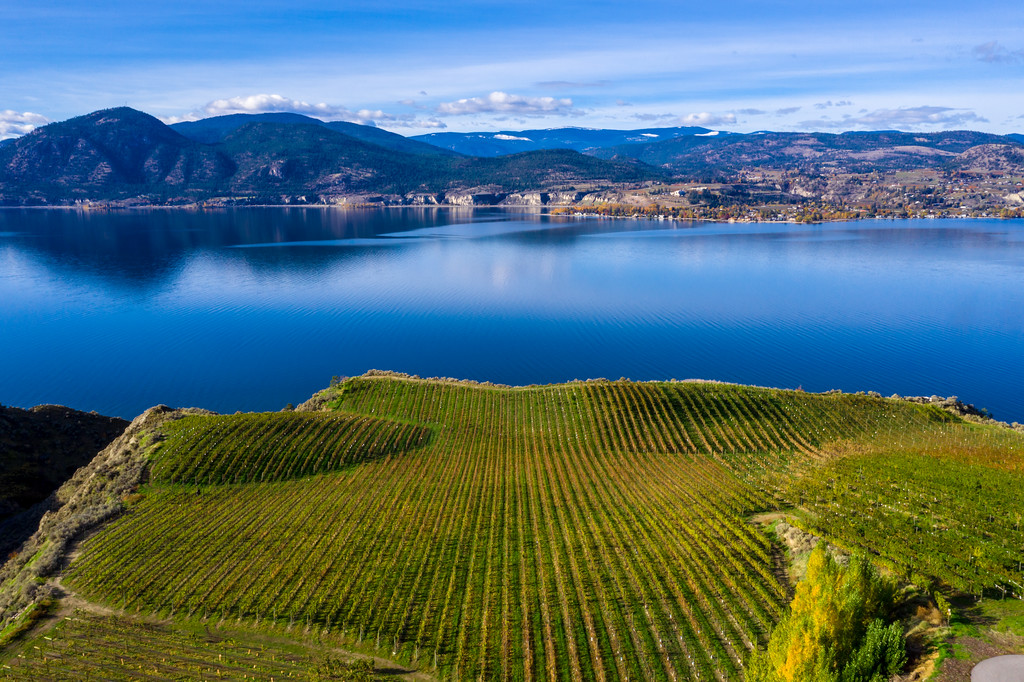Climate change is expanding wine regions around the world. If until recently even a region with a growing history like British Columbia could leave the most demanding wine professionals skeptical, today, the interest in British Columbia is much more than simple curiosity.
2023 celebrates 33 years of wines produced in British Columbia’s Vintners Quality Alliance (BC VQA) designation. An industry that has grown from just 19 wineries in 1990 to over 330 in 2023.

©WINES OF BRITISH COLUMBIA
The region has 11,086 acres (4,486 hectares) of wine grapes in British Columbia’s nine Geographical Indications (GIs): Okanagan Valley, Similkameen Valley, Fraser Valley, Vancouver Island, Gulf Islands, Thompson Valley, Lillooet, Shuswap, Kootenays and beyond.
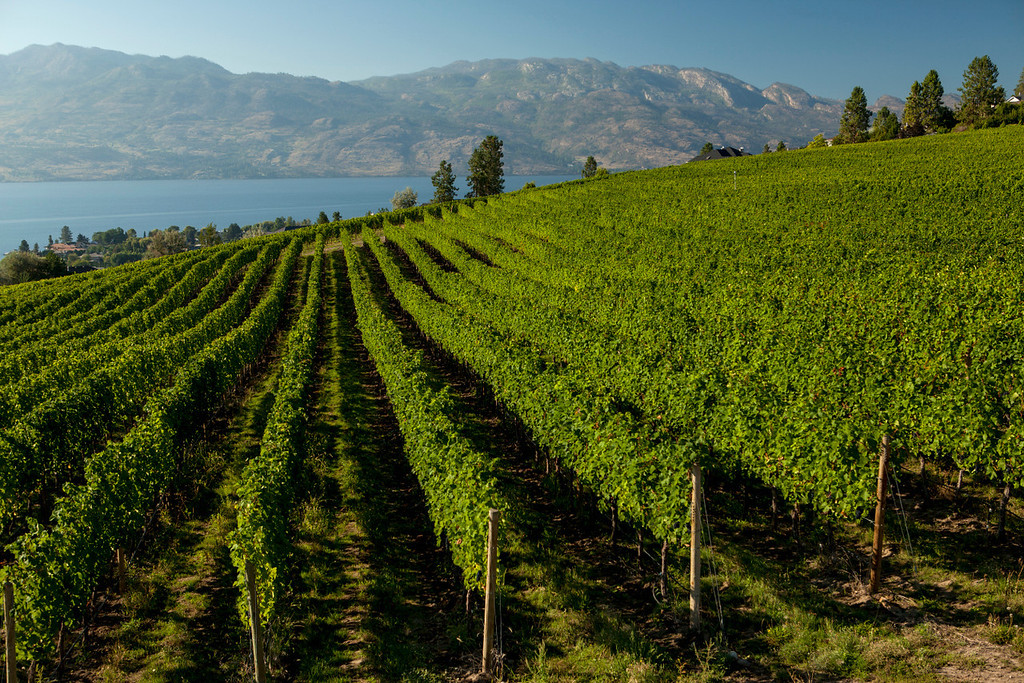
©WINES OF BRITISH COLUMBIA
Hotter and drier than Napa Valley, the Okanagan Valley receives nearly two hours more sunlight per day than Napa during the peak growing season of July and August.
The most planted red grapes are: Merlot, Pinot Noir, Cabernet Sauvignon, Cabernet Franc, Syrah/Shiraz, Gamay Noir.
The most planted white grapes are: Pinot Gris, Chardonnay, Gewürztraminer, Riesling, Sauvignon Blanc, Viognier.
BC has the unique combination of extreme heat and cold which results in intense fruity, fresh and structured wines.
90% of all BC vineyards are located in the Okanagan Valley and Similkameen Valley, a four-hour drive east of the city of Vancouver. Between Vancouver and wine country lies the coastal mountain range. These towering mountains take moisture out of the climate from the Pacific Ocean, and while Vancouver is a coastal city, the Okanagan and Similkameen enjoy dry, desert-like conditions.
The arid desert region of the South Okanagan Valley is the northern point of the network of deserts that extends across the United States and into Mexico. Low rainfall and an abundance of sunshine facilitate sustainable agriculture and help produce pure, intensely fruity wines.
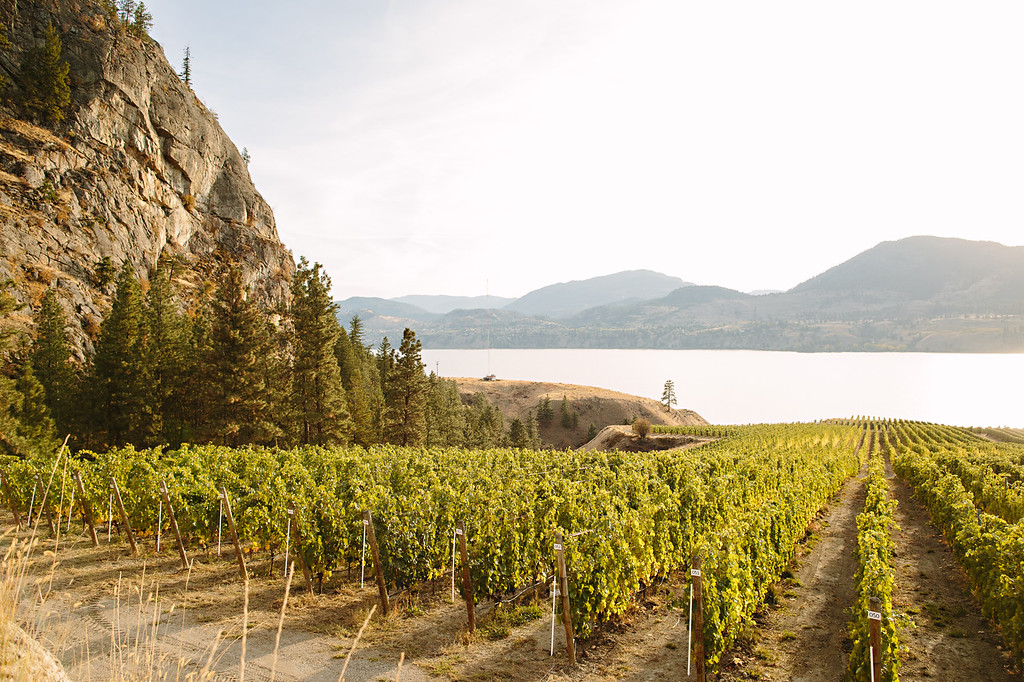
©WINES OF BRITISH COLUMBIA
In a day it is possible to record a significant temperature range. The diurnal temperature range (between day and night) can reach 30°C (86°F), which is very rare anywhere else in the world. Temperatures in winter can drop below -20°C (-4°F) and then reach +40°C (104°F) in summer. Viticulture in British Columbia is all about extremes. While sun and heat create intense fruit aromas in the wines, cool nights preserve natural acidity keeping the wines fresh and lively – a hallmark of British Columbia wines.
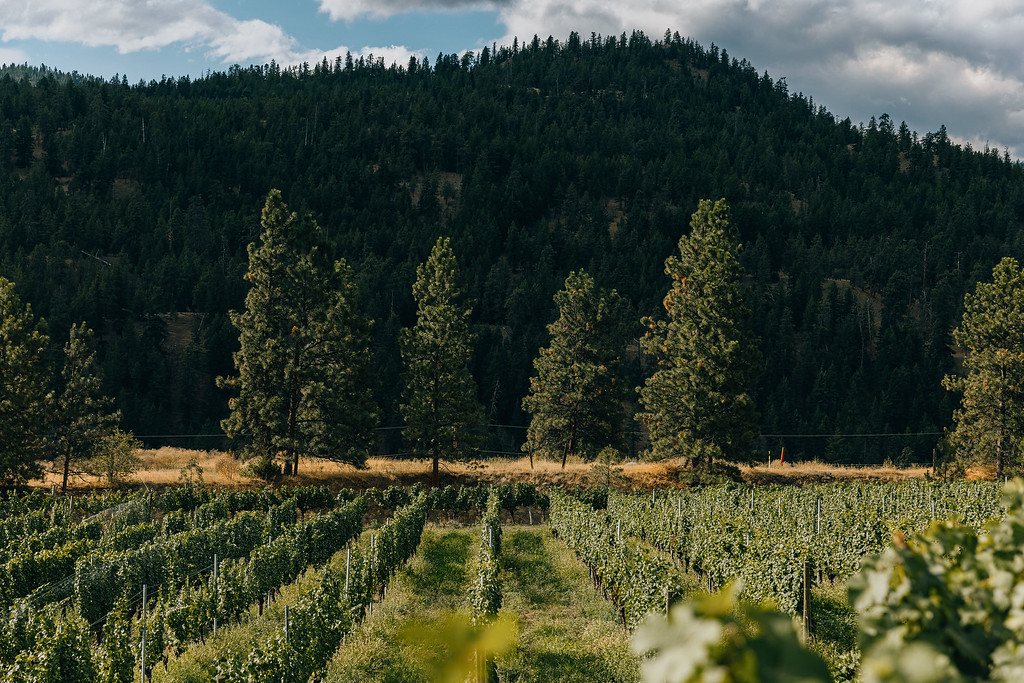
©WINES OF BRITISH COLUMBIA
The northern latitude also has a great advantage when it comes to sunlight. During the peak of the growing season, British Columbia vineyards have up to two hours more sunlight per day than popular regions like California’s Napa Valley.
The combination of dry conditions, hot days and long daylight hours with plenty of sunlight causes the Okanagan Valley and Similkameen Valley to have a condensed, warm and intense growing season. Budding can begin weeks later in places like Bordeaux in France, but harvest often occurs around the same time, between September and October. This short, warm growing season is unique to British Columbia – there is nothing like it in the world.
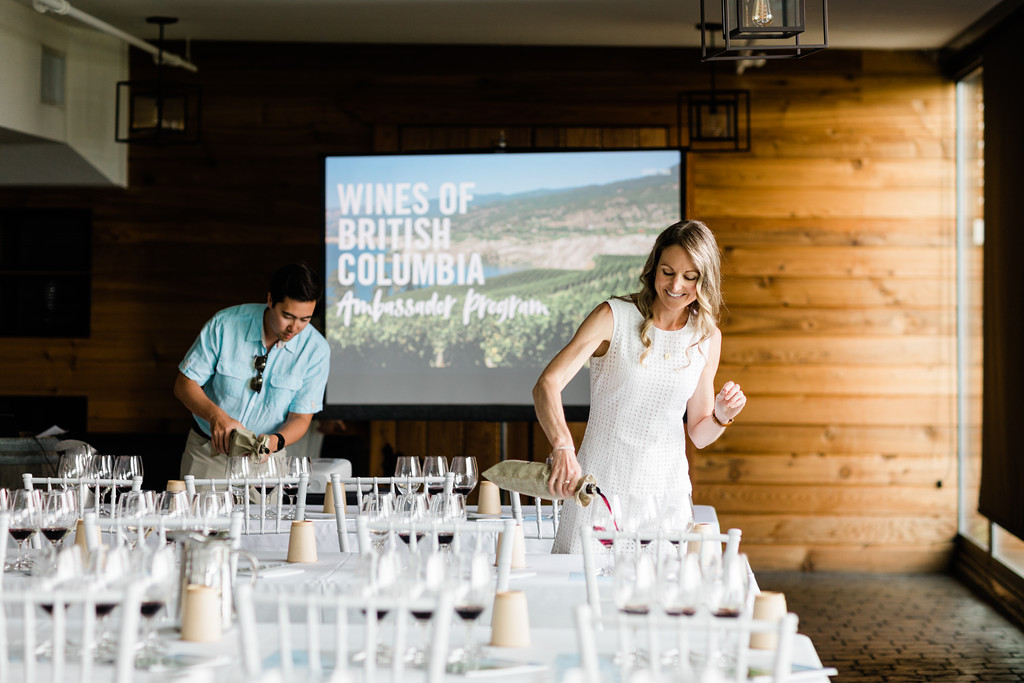
©WINES OF BRITISH COLUMBIA
A unique climate that produces unique wines, with bright natural acidity along with ripe fruit. In red wines there is also a natural tannic structure which gives great aging capacity.
The wine industry in BC began in the 1990s when, with the free trade agreement between Canada and the United States, production focused on quality and not quantity.
With the onset of free trade, two-thirds of the vine acreage was removed, leaving only 1,134 acres of grapes in 1990, of which only half was estimated to be quality vinifera grapes.
Initially, British Columbia’s wine industry looked to the rest of the wine world for inspiration, and wines attempted to imitate some of the tried and true styles and techniques of other, more established regions. Now, with over 30 years of experience, British Columbia wines have their own style that expresses the unique terroir.
Regions of British Columbia
OKANAGAN VALLEY
The Okanagan Valley is home to the majority of its wineries. The climate is extreme, with temperatures as low as -20°C (-4°F) in winter and highs as high as +40°C (104°F) in summer.
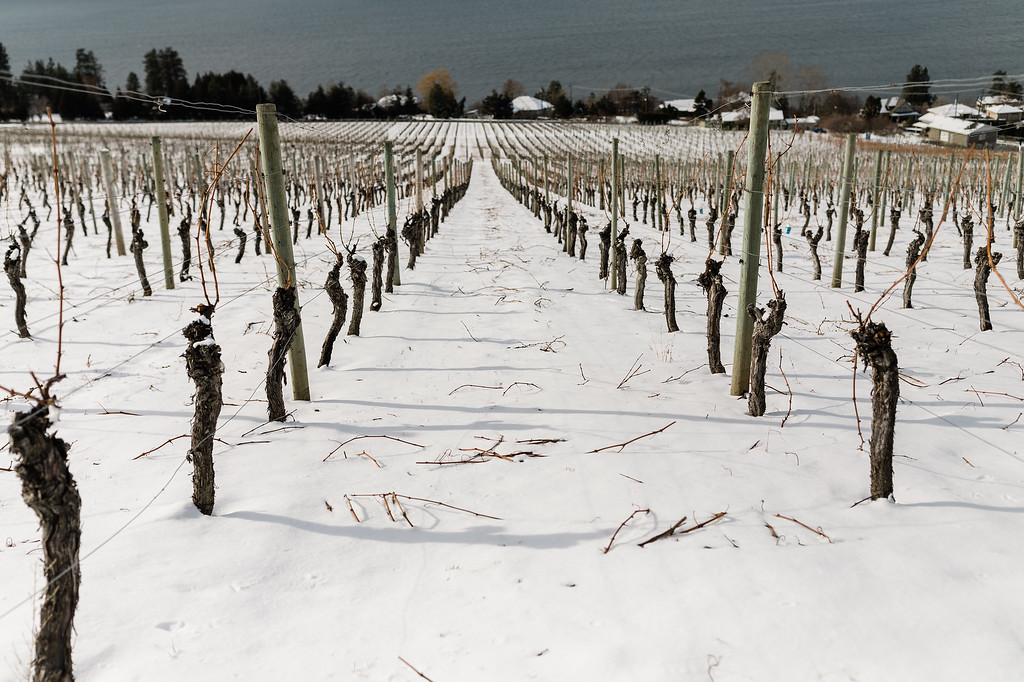
©WINES OF BRITISH COLUMBIA
The vineyards are mostly planted on the low slopes of the sometimes steep valley walls. The north-south direction of the Okanagan Valley results in vineyards on both the east and west sides of the valley. The east side is much warmer than the west side of the valley as it receives warm afternoon sun into the evening. There can be differences in ripening of up to two weeks for the same variety at the same latitude, depending on which side of the valley it is planted on.
The series of lakes starting from Osoyoos Lake on the U.S. border through most areas of the Okanagan Valley provide some natural moderation of the harsh climate, protecting the vineyards from spring and fall frosts and extreme winter cold. Due to the large size of the Okanagan Valley with many different terroirs, new smaller sub-GIs are being created that reflect the variability in climate and grape varieties that are successful in different parts of the valley.
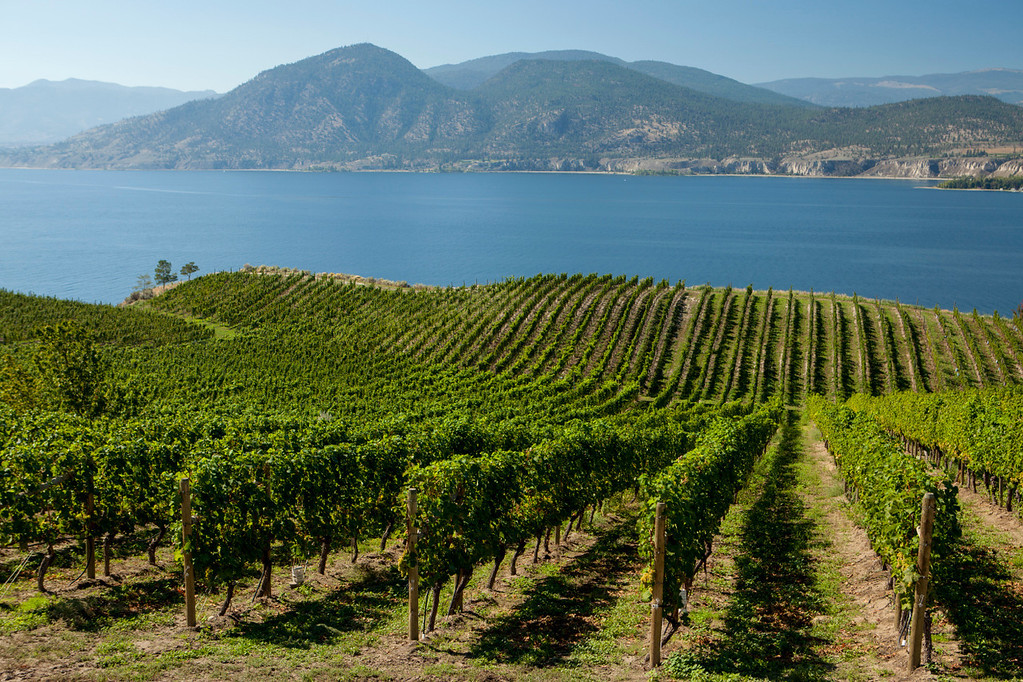
©WINES OF BRITISH COLUMBIA
SIMILKAMEEN VALLEY
The Similkameen Valley GI is located just west of Osoyoos in southern British Columbia, with most of the vineyards around Cawston and Keremeos. It has a climate similar to that of the South Okanagan, with hot and dry semi-desert conditions. The valley has 6% of BC’s vineyard area and a very diverse terroir. Around the town of Keremeos there are some vineyards on warmer soils but, due to the sudden, steep mountains that rise above the grapes, many areas become shaded in the early hours of the day and in the depths of winter they see almost no sunlight. Sun. Moving east towards the town of Cawston, the soil is more suitable for growing late-ripening grapes. In many parts of the world this would be considered high altitude viticulture with vineyards ranging from 400 to 480 meters above sea level. The soils are often gravelly and in many areas there are numerous stones on the surface. Many vineyard soils are rich in calcium carbonate which imparts mineral flavors to many wines. With no lakes in the Similkameen Valley, the region is subject to extremes of both heat and cold, but the Similkameen River and a persistent, often powerful wind can help reduce the temperature extremes. The wind is also significant in keeping the vineyards free from pests and diseases and contributes in part to the fact that Similkameen has the highest density of certified organic fruits and vegetables in all of Canada. Due to the varied climate, a wide range of grapes can be successful: from Merlot, Cabernet Franc, Cabernet Sauvignon and Syrah to the early-ripening Gamay Noir and Pinot Noir and the white varieties Chardonnay, Riesling and Pinot Grigio.
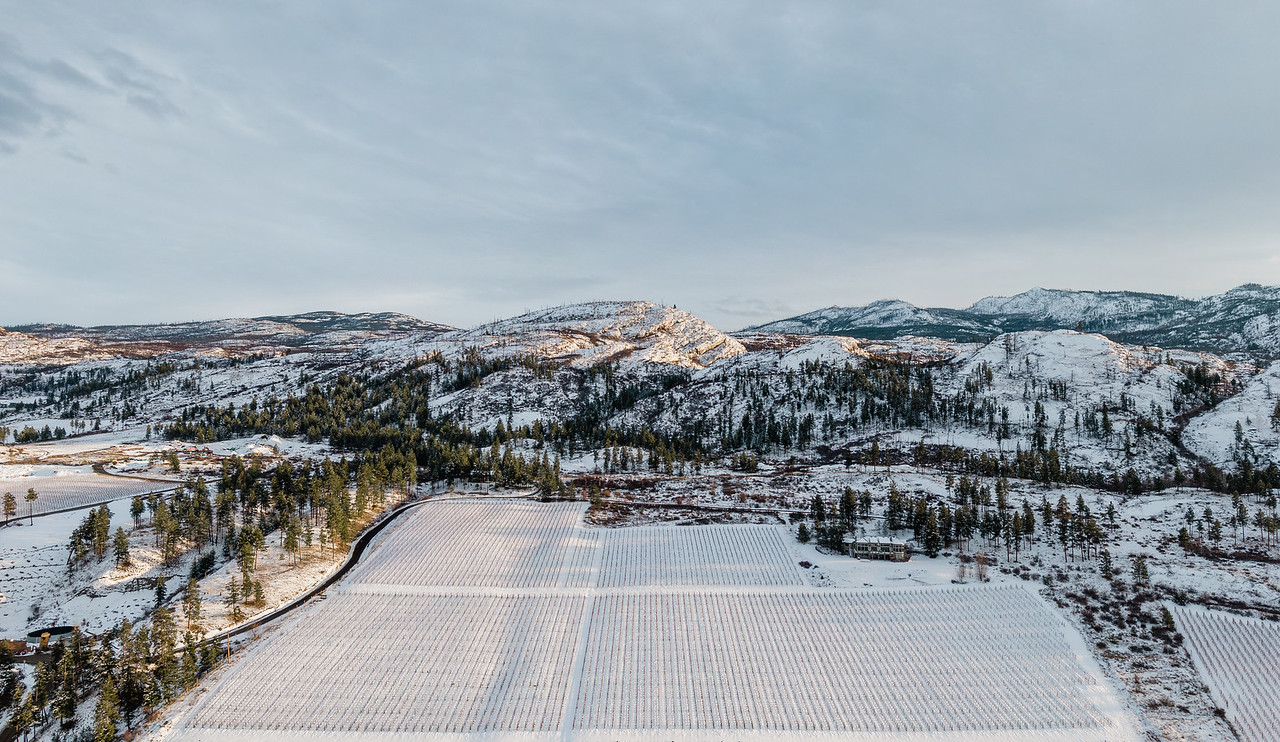
©WINES OF BRITISH COLUMBIA
VANCOUVER ISLAND (COWICHAN VALLEY SUB-GI)
Vancouver Island vineyards are mostly located in the southeastern part of the island, which has a Mediterranean-type climate with cool, wet winters and hot, dry summers. A strong maritime influence moderates seasonal temperature variation.
While generally cool regions, the lower rainfall and long frost-free season allow for sufficient growth rates for a wide range of potential cool climate grape varieties including Pinot Noir, Pinot Grigio, Maréchal Foch, Ortega, Chardonnay, Gewürztraminer and many others. Vancouver Island’s vineyards are concentrated in the Cowichan Valley, near the town of Duncan. There are also producers near Nanaimo, as well as on the Saanich Peninsula, some even near the city of Victoria. A total of 277 acres are planted with vines. The soils are a mixture with the retreat of glaciers and the uplift of the ocean floor up to 100 meters above sea level, leaving behind marine sediments, glaciofluvial sediments and glacial deposits.
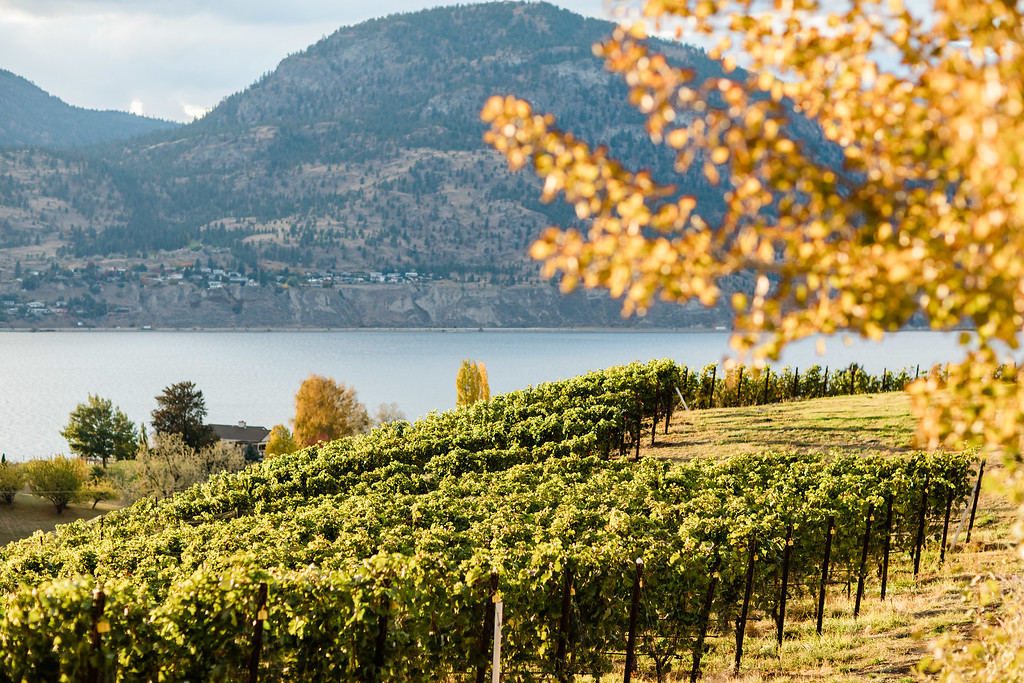
©WINES OF BRITISH COLUMBIA
COWICHAN VALLEY SUB-GI
In 2020, the Cowichan Valley was officially recognized as the first sub-geographic designation outside of the Okanagan Valley. The Cowichan Valley sub-GI is roughly defined as the area between the Cowichan watershed, the eastern shoreline from Mill Bay to Maple Bay, and the western area of Cowichan Lake. Cowichan Valley vineyards boast ideal conditions for popular grape varieties including Ortega, Bacchus, Gewürztraminer, Pinot Grigio, Marechal Foch and Pinot Noir. Cowichan Valley wineries are generally protected from Pacific Ocean storms by nearby mountains and have a long growing season with a low risk of frost.
GULF ISLANDS
The Gulf Islands are a small region made up of numerous islands between the mainland and Vancouver Island. The Gulf Islands region is now home to vineyards and/or wineries on Salt Spring, Pender, Saturna and Bowen Islands. There are approximately 79 acres of cultivation with similar climate and grape varieties on Vancouver Island GI. The first vineyards were planted on Saturna Island in 1995.
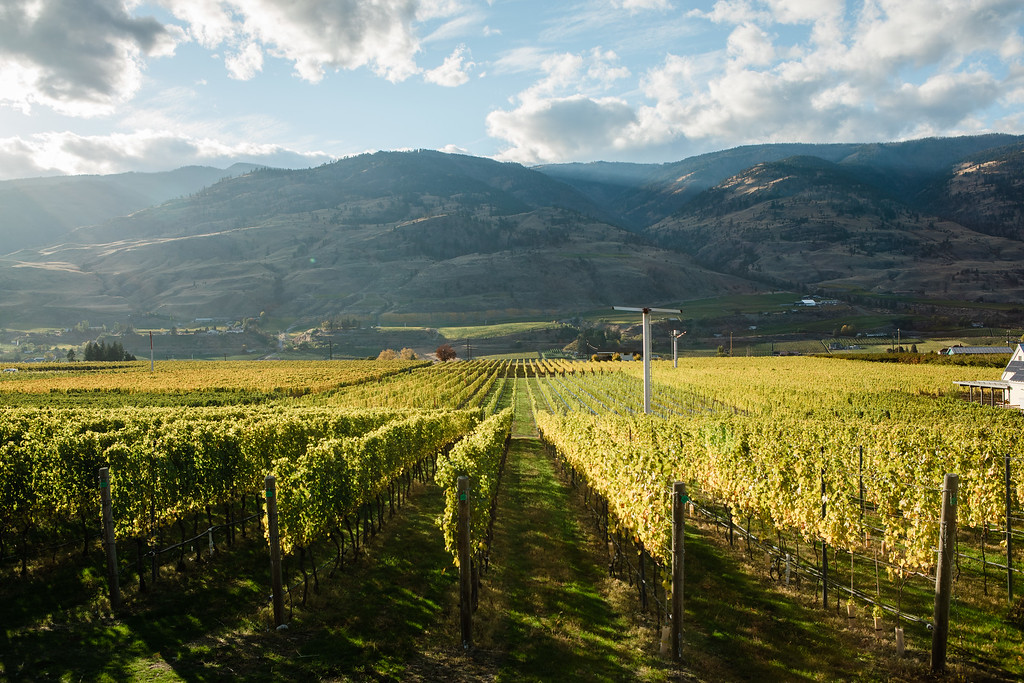
©WINES OF BRITISH COLUMBIA
FRASER VALLEY
The terroir of the Fraser Valley is very different from that of the Okanagan Valley and other inland regions. The coastal influence causes the diurnal temperature variation to be much lower and precipitation to be much higher. Precipitation varies considerably in the Fraser Valley, so the specific site has a big influence. A key advantage for the region is the low risk of frost and winter damage. There is a wide range of early maturing varieties planted, including a number of recently developed experimental hybrids.
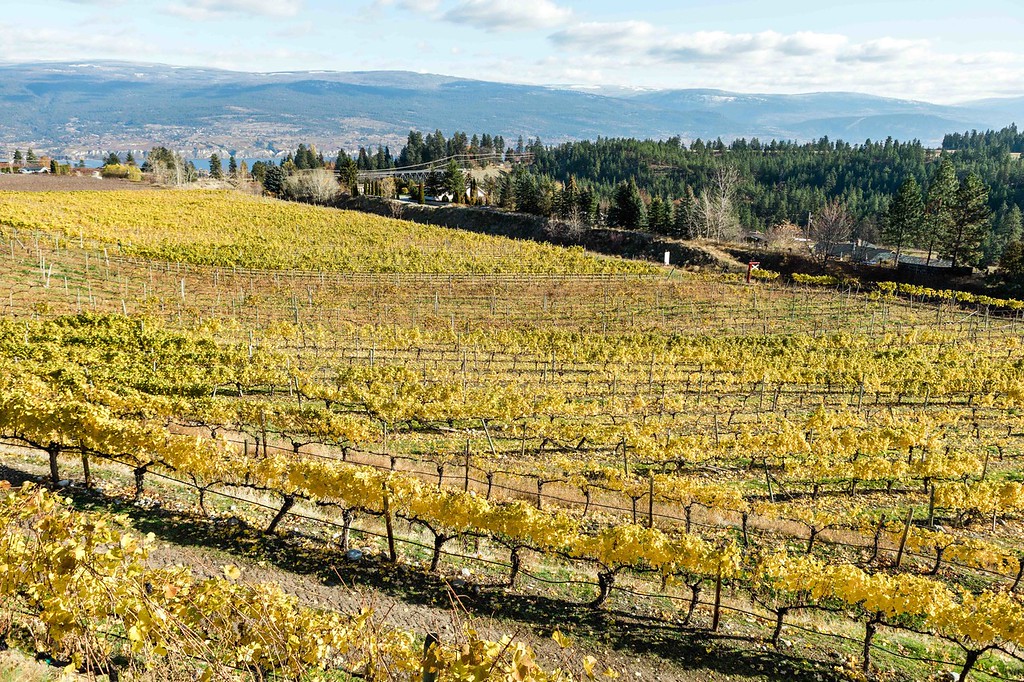
©WINES OF BRITISH COLUMBIA
THOMPSON VALLEY
90 acres are cultivated in the region. A semi-arid region, Thompson Valley has hot, dry summers and cold winters. The constant movement of the Thompson Rivers north and south creates an airflow that helps moderate temperatures providing many options for winemakers to shine with winter-hardy hybrids and vinifera varieties such as Riesling, Chardonnay and Pinot Noir.
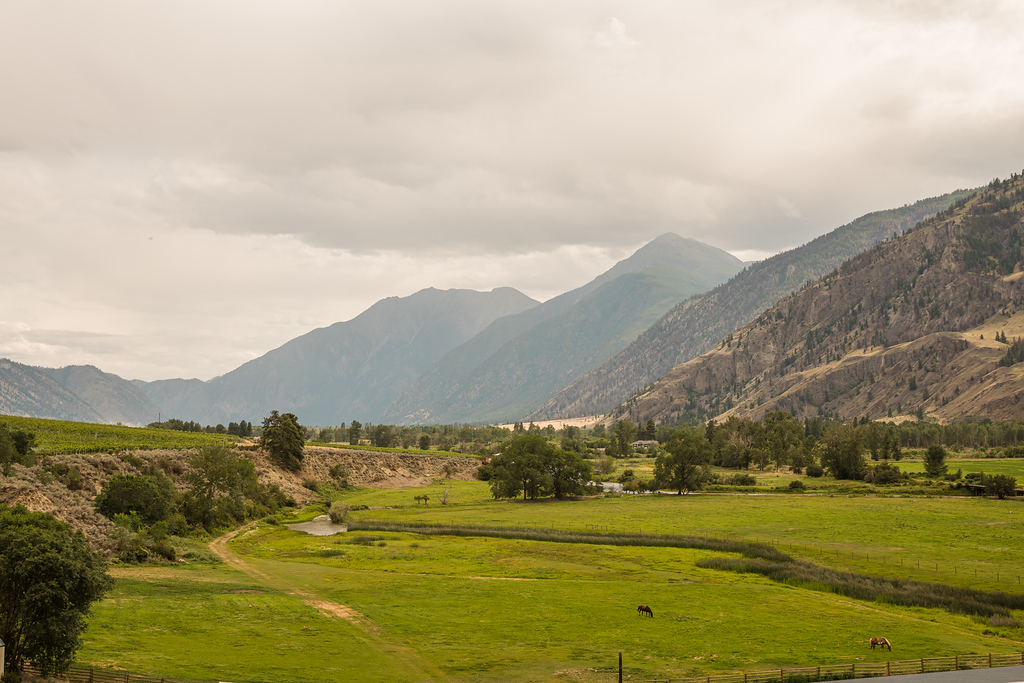
©WINES OF BRITISH COLUMBIA
LILLOOET
The Lillooet GI covers a 100km stretch of the inner Fraser River valley from Pavilion in the north to Kanaka Bar in the south. The region has a mountainous landscape and an upper altitude of around 1,000 metres, however, due to the steepness of the valley walls, wine production is currently climatically suited to altitudes below 500 meters and the largest vineyards are located at 230 metres, much lower than most inland vineyards. This contributes to high growth in degree days even at the northern latitude of 50.68. The mountain range to the west creates a climate similar to the traditional viticultural regions in the southern Okanagan Valley, with long, hot, dry summers. However, nights can be cool, preserving the fresh, crisp acidity in the wines. Successful varieties include Riesling, Pinot Noir, Cabernet Franc, Chardonnay and Pinot Grigio.
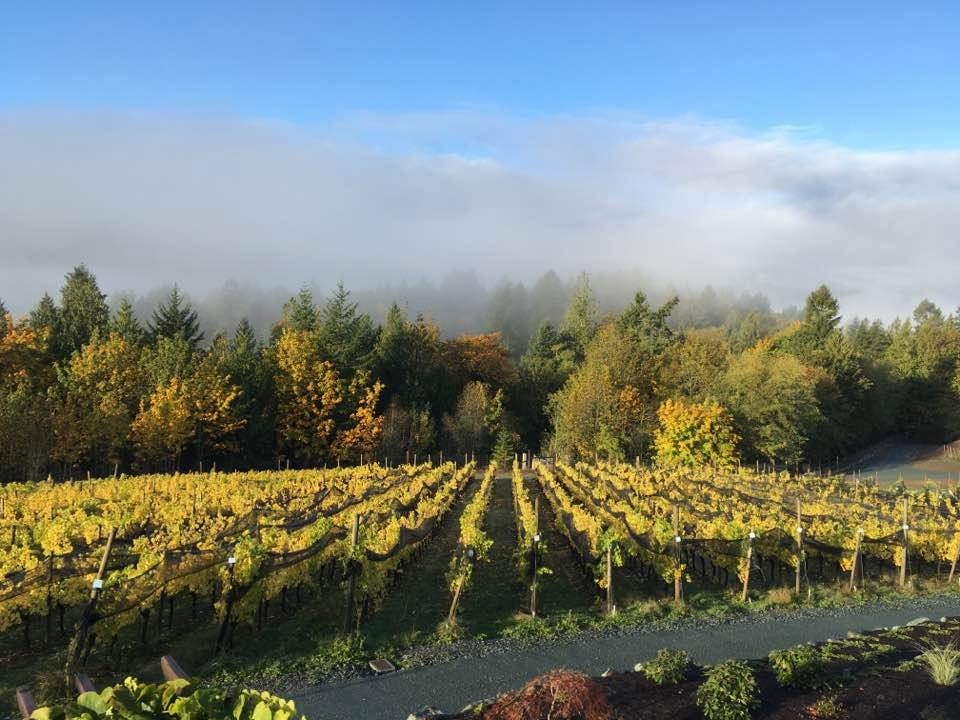
©WINES OF BRITISH COLUMBIA
SHUSWAP
The Shuswap region is located north of the Okanagan Valley and east of the Thompson Valley. It is a diverse area that includes several major rivers that flow into Shuswap Lake, the dominant feature of the region. The GI boundary follows the Shuswap Basin watershed and is designed to capture areas that have landscape and climate conditions suitable for agriculture. Much of the Shuswap watershed is composed of rugged, high-elevation mountain ranges in the Columbia Mountains, where viticulture would not be possible. The GI has an upper elevation limit of approximately 1000 metres, well above the currently climatically suitable elevation for agriculture, but included for potential future expansion. Wines have been made here since 1997, predominantly from cool-climate varieties, which is understandable given that it is one of the northernmost wine regions in North America and the coolest of British Columbia’s inland wine regions. The approximately 100 acres of vineyards are scattered throughout the region, each with its own microclimate.
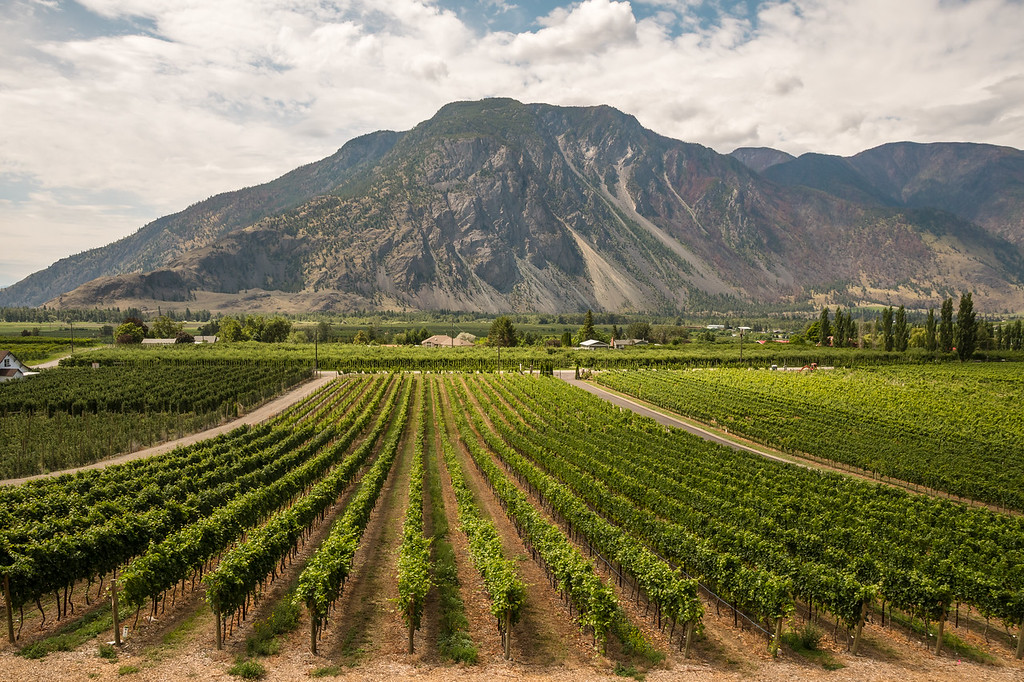
KOOTENAYS
The Kootenays GI is a vast mountainous area of over 2 million hectares (4.9 million acres), however only a small portion of this is currently suitable for wine production. The boundaries of the IG are defined primarily by watershed boundaries, specifically the Kootenay River watershed from the U.S. border to Balfour and then along the Kootenay River to Castlegar, the Slocan watershed, the Columbia River drainage from Lower Arrow Lake and the Columbia River to the U.S. border, the Granby River watershed, and the lower Kettle River from the Okanagan Basin divide east of Osoyoos, including areas around Rock Creek and Grand Forks . There is a deviation from the boundaries based on water drainage in the northern part of the GI where the area surrounding Nakusp has been included in the GI. Much of the area within the GI is high altitude and climatically unsuitable for agriculture. Viticulture occurs along the region’s valley floors in the warmer parts of the IG, particularly in the Creston Valley, Grand Forks area, and with potential in the Rock Creek area. The most widely planted grape variety in the GI is Pinot Noir, followed by other vinifera varieties including Gewürztraminer, Pinot Grigio, Chardonnay and Riesling.
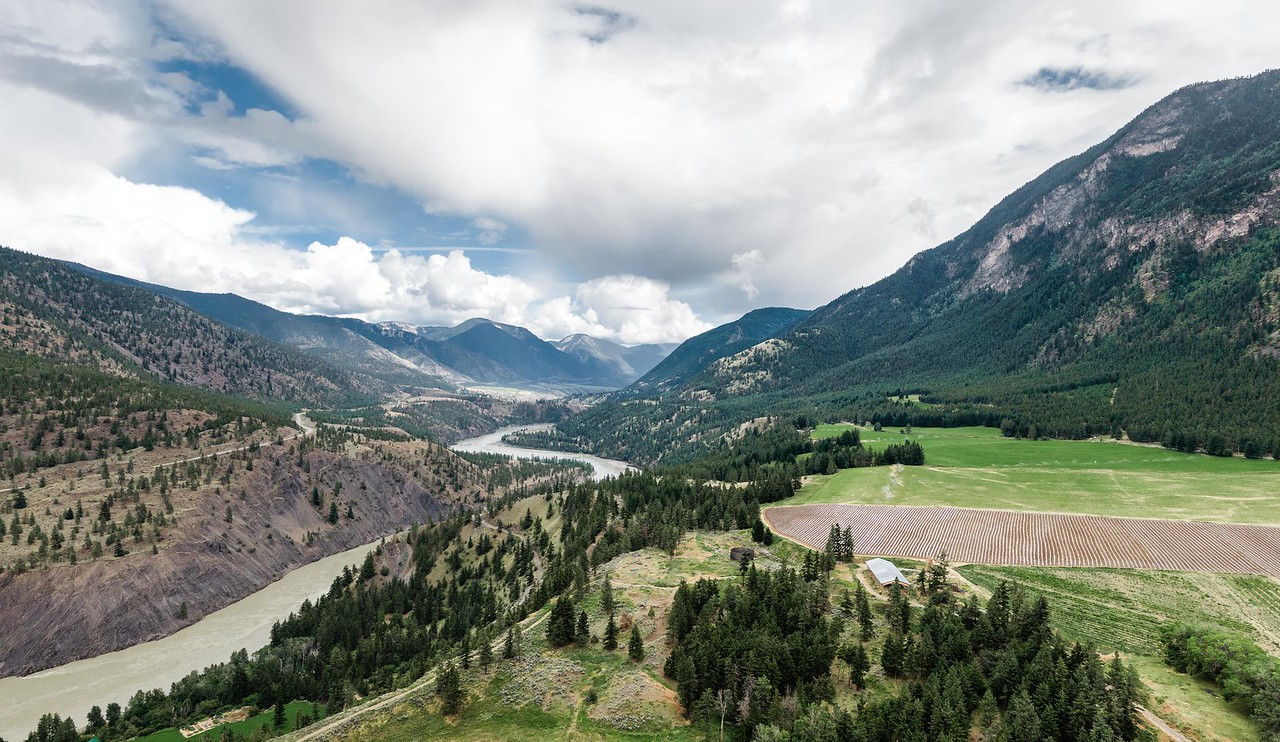
©WINES OF BRITISH COLUMBIA
The reality of BC looks to the future with sustainable agriculture facilitated by the dry, sunny climate, with low humidity and low rainfall combined with hot summers and cold winters. There are few pests and diseases to worry about and as a result more and more farmers and producers are following the guidelines of organic, biodynamic or sustainable viticulture. It too is proposed as another of the New World regions of interest, especially in the near future.


